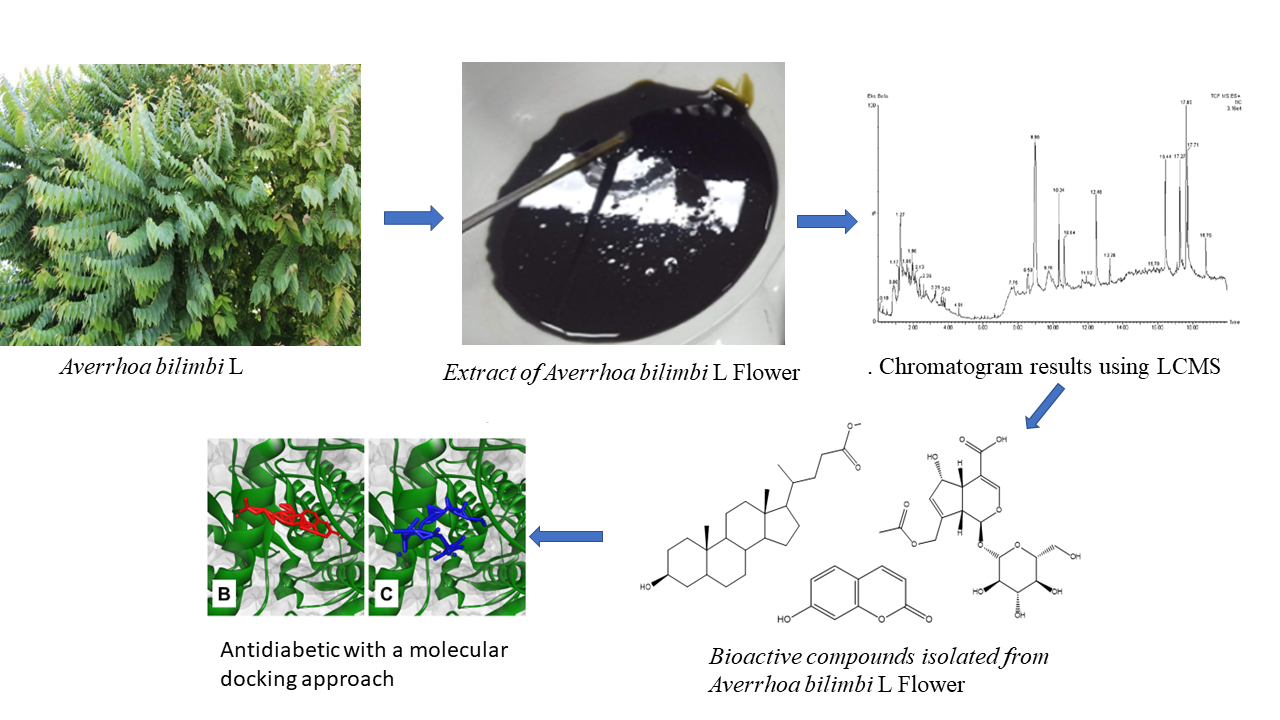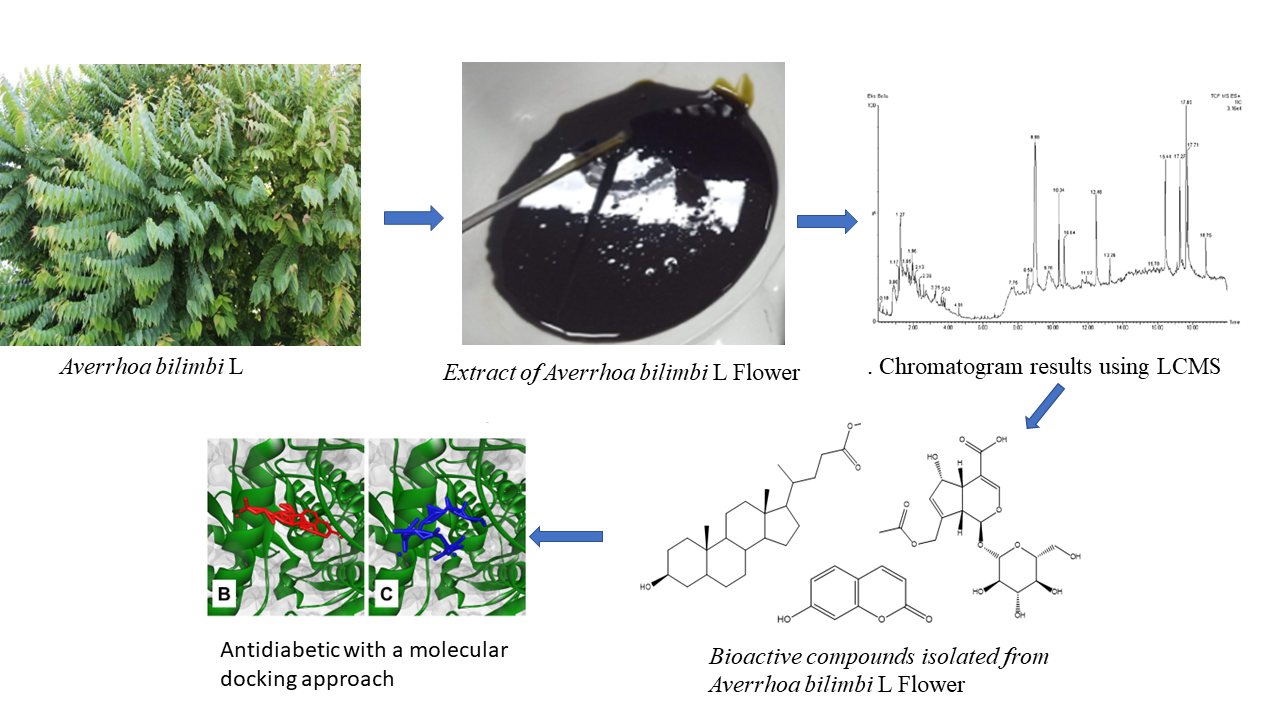Identification of Active Compounds from Averrhoa bilimbi L. (Belimbing Wuluh) Flower using LC-MS and Antidiabetic Activity Test using in vitro and in silico Approaches
DOI:
https://doi.org/10.48048/tis.2023.6761Keywords:
Antidiabetic test, Averrhoa bilimbi L, In silico, Lithocholic acid, LC-MS, TautomycetinAbstract
Averrhoa bilimbi L., (Belimbing wuluh), is traditionally used for various antidiabetic, anti-larvicidal, antioxidant, hypoallergenic, antibacterial, antifungal, and anti-inflammatory treatments. This study evaluated 3 extracts (n-hexane, ethyl acetate, and n-butanol) isolated from starfruit flowers for antidiabetic effects using in vitro and in silico methods. Ethyl acetate extract showed the highest activity, followed by n-hexane and n-butanol extracts in inhibiting α-glucosidase. Each extract has an IC50 value of 89.84, 52.88, and 114.86 µg/mL. The active compounds contained in the ethyl acetate extract were determined using LC-MS, and the compounds with the highest retention time were identified as tautomycetin (8.585) and lithocholic acid (8.993). Tautomycetin and lithocholic acid showed promising results in the in silico test. The computational predictions showed that tautomycetin (−6.2 kcal/mol) and lithocholic acid (−10.0 kcal/mol) have better binding affinity values than miglitol (−5.4 kcal/mol). This is the first time the antidiabetic test of starfruit flower extract has been carried out.
HIGHLIGHTS
- Averrhoa bilimbi L well-known as belimbing wuluh. is a highly nutritious plant and an endemic and tropical species mainly used as a traditional medicine to treat several diseases. Its fruit is food with economic value in Indonesia
- Extracts of ethyl acetate from the flower showed the highest antidiabetic activity with IC50 52.88 μg/mL
- In the phytochemical determination from Averrhoa bilimbi L flower using Liquid Chromatography Mass Spectrometer (LC-MS), several compounds were suspected of having antidiabetic activity, namely the compound lithocholic acid, and tautomycetin
- Lithocholic acid and tautomycetin have been tested for their bioactivity as antidiabetic with in vitro and in vivo methods
GRAPHICAL ABSTRACT
Downloads
Metrics
References
D Widiastuti, AH Mulyati, E Herlina, S Warnasih, Triastinurmiatiningsih and U Supratman. Cytotoxic effects of cassava (Manihot esculenta Crantz), Adira-2, karikil and sao pedro petro varieties against P-388 murine leukemia cells. Res. J. Chem. Environ. 2018; 22, 206-8.
D Widiastuti, S Salam, D Haneti, R Lesmana, MA Nafiah and U Supratman. Flavonoid from the Sao Pedro Petro of tubers of cassava (Manihot esculenta Crantz). Res. J. Chem. Environ. 2019; 23, 111-3.
SE Sinaga, T Mayanti, AA Naini, D Harneti, Nurlelasari, R Maharani, K Farabi, U Supratman, S Fajriah and MN Azmi. Sesquiterpenoids from the stem bark of Lansium domesticum Corr. Cv. Kokossan and their cytotoxic activity against MCF-7 breast cancer cell lines. Indones. J. Chem. 2022; 22, 1035-42.
T Mayanti, SE Sinaga and U Supratman. Phytochemistry and biological activity of Lansium domesticum Corr. species: A review. J. Pharm. Pharmacol. 2022; 74, 1568-87.
J Husnul and Ridwan. Pengobatan tradisional suku Sasak bebasis ilmiah di Kabupaten Lombok Barat. J. Ilm. Biol. 2017; 1, 116-25.
HY Setyawan, S Sukardi and BF Nareswari. The phytochemical potential of Averrhoa bilimbi - A review. IOP Conf. Ser. Earth Environ. Sci. 2021; 733, 012091.
N Muthu, SY Lee, KK Phua and SJ Bhore. Nutritional, medicinal and toxicological attributes of star-fruits (Averrhoa carambola L.): A review. Bioinformation 2016; 12, 420-4.
SB Kurup and S Mini. Averrhoa bilimbi fruits attenuate hyperglycemia-mediated oxidative stress in streptozotocin-induced diabetic rats. J. Food Drug Anal. 2017; 25, 360-8.
SB Kurup. Protective potential of Averrhoa bilimbi fruits in ameliorating the hepatic key enzymes in streptozotocin-induced diabetic rats. Biomed. Pharmacother. 2017; 85, 725-32.
A Hidayatullah, WE Putra, S Sustiprijatno, D Widiastuti, WO Salma and MF Heikal. Molecular docking and molecular dynamics simulation-based identification of natural inhibitors against druggable human papilloma virus type 16 target. Trends Sci. 2023; 20, 4891.
A Hidayatullah, WE Putra, M Rifa’i, Sustiprijatno; D Widiastuti, MF Heikal, H Susanto, WO Salma and H Mulyadi. Molecular docking and dynamics simulation studies to predict multiple medicinal plants’ bioactive compounds interaction and its behavior on the surface of denv-2 e protein. Karbala Int. J. Mod. Sci. 2022; 8, 531-42.
HM Kim and CG Hyun. Miglitol, an oral antidiabetic drug, downregulates melanogenesis in b16f10 melanoma cells through the pka, mapk, and gsk3β/β-catenin signaling pathways. Molecules 2023; 28, 115.
RP Dash, RJ Babu and NR Srinivas. Reappraisal and perspectives of clinical drug - drug interaction potential of α-glucosidase inhibitors such as acarbose, voglibose and miglitol in the treatment of type 2 diabetes mellitus. Xenobiotica 2018; 48, 89-108.
SM Patil, RM Martiz, R Ramu, PS Shirahatti, A Prakash, BRP Kumar and N Kumar. Evaluation of flavonoids from banana pseudostem and flower (quercetin and catechin) as potent inhibitors of α-glucosidase: An in silico perspective. J. Biomol. Struct. Dyn. 2022; 40, 12491-505.
MS Lee and PT Thuong. Stimulation of glucose uptake by triterpenoids from Weigela subsessilis. Phyther. Res. 2009; 24, 49-53.
D Sukandar, S Hermanto and IA Mabrur. Aktivitas senyawa antidiabetes ektrak etil asetat daun pandan wangi (Pandanus Amaryllifolius Roxb.). Jurnal Kimia Valensi 2010; 12, 269-73.
LO Sumarlin, D Sukandar and L Pratiwi. Aktivitas Penghambatan α-Glukosidase Campuran Ekstrak Daun Namnam (Cynometra cauliflora L.) dan Madu Kaliandra. al-Kimiya. 2020; 6, 87–94.
D Kalita, DG Holm, DV LaBarbera, JM Petrash and SS Jayanty. Inhibition of α-glucosidase, α-amylase, and aldose reductase by potato polyphenolic compounds. PLoS One. 2018; 13, e0191025.
A Schäfer and P Högger. Oligomeric procyanidins of French maritime pine bark extract (Pycnogenol®) effectively inhibit α-glucosidase. Diabetes Res. Clin. Pract. 2007; 77, 41-6.
X Zhou J Liang, Y Zhang, H Zhao, Y Guo and S Shi. Separation and purification of α-glucosidase inhibitors from Polygonatum odoratum by stepwise high-speed counter-current chromatography combined with Sephadex LH-20 chromatography target-guided by ultrafiltration-HPLC screening. J. Chromatogr. B Anal. Tech. Biomed. Life Sci. 2015; 985, 149-54.
A Ambethkar and S Ananthalakshmi. GC-MS analysis on the methanolic extract of Trichosanthes anguina L. root. Int. J. Pharm. Life Sci. 2014; 5, 3389-93.
L Milella, S Milazzo, MD Leo, MBV Saltos, I Faraone, T Tuccinardi, M Lapillo, ND Tommasi and A Braca. α-Glucosidase and α-Amylase inhibitors from Arcytophyllum thymifolium. J. Nat. Prod. 2016; 79, 2104-12.
R Ramu, PS Shirahatti, F Zameer, DB Lakkapa and MN Nagendra Prasad. Evaluation of banana (Musa sp. var. nanjangud rasa bale) flower and pseudostem extracts on antimicrobial, cytotoxicity and thrombolytic activities. Int. J. Pharm. Pharm. Sci. 2015; 7, 136-40.
N Agrawal, M Sharma, S Singh and A Goyal. Recent advances of α-Glucosidase inhibitors: A comprehensive review. Curr. Top. Med. Chem. 2022; 22, 2069-86.
H Kashtoh and KH Baek, Recent updates on phytoconstituent alpha-glucosidase inhibitors: An approach towards the treatment of type two diabetes. Plants 2022; 11, 2722.
M Callahanid, AM Trestonid, G Lin, M Smith, B Kaufman, K Spurgers, KL Warfield and P Lowe. Randomized single oral dose phase 1 study of safety, tolerability, and pharmacokinetics of Iminosugar UV-4 Hydrochloride (UV-4B) in healthy subjects. PLoS Negl. Trop. Dis. 2022; 16, e0010636.
Q Xue, X Liu, P Russell, J Li, W Pan, J Fu Zhang, A. Evaluation of the binding performance of flavonoids to estrogen receptor alpha by Autodock, Autodock Vina and Surflex-Dock. Ecotoxicol. Environ. Saf. 2022; 233, 113323.
S Tsalamandris, AS Antonopoulos, E Oikonomou, G Papamikroulis and G Vogiatzi. Risk factors and cardiovascular disease prevention the role of inflammation in diabetes: Current concepts and future perspectives. Eur. Cardiol. Rev. 2019; 14, 50-9.
TV Rohm, DT Meier, JM Olefsky and MY Donath. Inflammation in obesity, diabetes, and related disorders. Immunity 2022; 55, 31-55.

Downloads
Published
How to Cite
Issue
Section
License
Copyright (c) 2023 Walailak University

This work is licensed under a Creative Commons Attribution-NonCommercial-NoDerivatives 4.0 International License.






